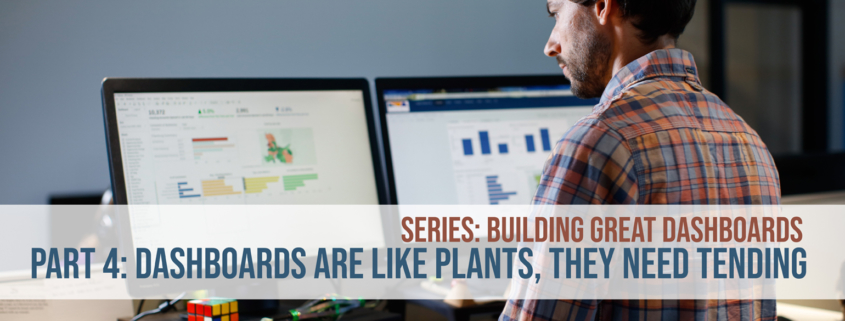Part 4: Dashboards are Like Plants, They Need Tending
Building Great Dashboards Series
Part 4: Dashboards are Like Plants, They Need Tending
This is the fourth, and final, part of our series on building great dashboards. If you have not read the earlier posts you can find them here:
Part 1: Gathering Requirements
Part 3: Solicit Feedback While Building a Dashboard
Our previous posts have explained several steps in the process of building dashboards. This post will focus on launching the dashboards and maintaining them.
Launch
The most important aspect of a successful launch is to make sure everyone who will be using the dashboard has seen the finished product and knows how to use it. If this is the first dashboard they are using, you will need to cover the basics of credentials and navigation as well. In a perfect world, doing each of these sessions one-on-one is the best way to ensure success. If the team is small enough and you have time, then go for it! More often though, this will be done in a large group, either in-person or remotely over a screen-sharing service. Either way, it is useful to record your sessions so that they can be viewed at a later date by current users and by new team members as part of their onboarding.
Maintenance
Is anyone even using this dashboard? That is the question many analysts may ask themselves after launch, and with most dashboard platforms you can look in at usage metrics to see who and how often users are logging in. Here are some key questions to focus on:
- Have all users logged in? – Check-in with anyone who has not signed in after a week or two to ensure they know how to access the dashboard and do not have any questions.
- Are users logging in after the initial burst of excitement around the launch? – People usually log in a lot right after the launch and then usage may drop off. This is natural as users initially tend to revert back to their previous workarounds, rather than using the dashboard. Make sure to remind users about the value of the dashboards and see if anything needs to be tweaked now that users have had access to it for a few weeks.
- Are all the different roles using it? – For example, if you built a dashboard for both sales and marketing teams, but only the marketing users are using it, check in with the sales team and see why. Is there something missing? What about their previous workarounds do they prefer? Many times, you will find that users do not want to ask for additional functionality immediately following a launch but sometimes the simplest updates can cause them to adopt.
After the initial launch period, you can keep an eye on usage and use periodic check-ins with the team to discuss how things are going and if their reporting needs have changed. Discuss how to incorporate these new requests into the dashboard and keep them up-to-date and relevant.
If your dashboard begins to get complicated or “too busy” with additional updates, then it may be time to spin off a new dashboard for specific questions.
The Great Dashboard Portal in the Sky
No matter how successful the launch, or how meticulous you are with maintenance, every dashboard eventually needs to be sent to the great dashboard portal in the sky.
Things are constantly changing. Maybe the team has been re-organized and has different goals. Maybe different data and systems are being used. Maybe it is just too complicated to keep tweaking and would be better to start fresh. No matter the ultimate cause of death, eventually every dashboard needs to be refreshed for the last time and shut down. Use this opportunity to take what you have learned and start the whole process over again to build a better, newer version. Try not to get too attached to any particular dashboard and always remember that you are trying to answer questions and make users’ work easier – not hold onto a dashboard for as long as possible.
Thank you for reading this series on building great dashboards. We really hope that it has been helpful for you now, and will continue to be a resource in the future. Feel free to drop us a comment to let us know what is – or is not – working for you. We are curious explorers here at SIGMA. Although we think this is the best way to build dashboards today, we are always discovering how to do things better tomorrow.
I want to give special thanks to Alyshia Olsen. She presented Design with the User in Mind at Tableau Conference 2017, which helped inspire the way SIGMA builds dashboards. You can check out that presentation and see other work she has completed at her website: alyshiaolsen.com.



